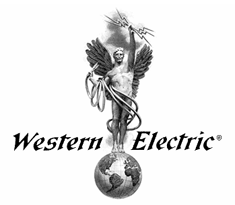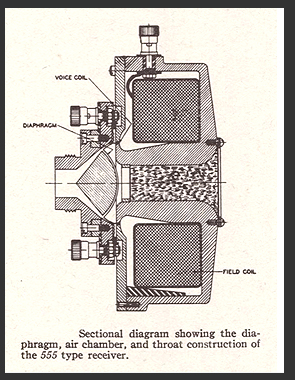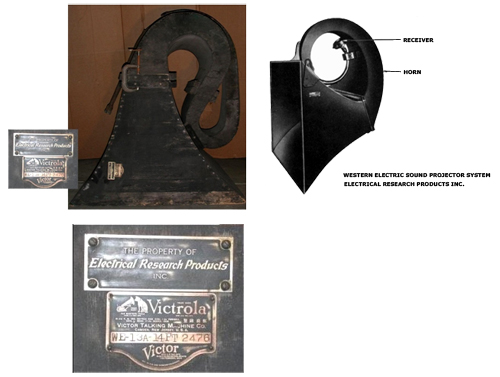

 |
 |
Western Electric Company had the best men in the world working for them at that time. Great men like Wente, Thuras, and so on.
These men, and dozens like them, were put to the task of making motion pictures talk. The men of Western Electric, due to their background with the telephone, naturally sought to design and build a "loud speaking telephone," as they were called, that would do the job. The result was a large, single transmitter mounted on a curving, single horn. It worked. In 1926, before one year when talking motion picture was born, Messrs Wente and Thuras of the Bell telephone Laboratories and Western Electric Company produced a horn loudspeaker with a moving coil mechanism driving a diaphragm and a powerful magnet system with a battery energized field coil. This gave power efficiency as high as 25% which enabled sound to be reproduced at much higher levels and with improved quality.  This was important since the amplifiers at that time only had an output of 2 watts. The driver unit was attached to an exponential horn, curved so as to conserve space behind the screen,
and multiple throats which allowed 2 or more units to be attached for increased output. Prototypes of these loudspeakers were used for the opening of Don Juan, starring John Barrymore, at the Wamer's Theatre in New York City on August 6, 1926, as part of the Western Electric sound on disc system.
Wente developed the moving coil speaker, "the Western Electric No.555 Receiver (Horn driver)" is described in patent 1,707,545 entitled "Acoustic Device", filed August 4, 1926 and granted April 2, 1929 . . . ."
An object of the invention is to receive and transmit sound with high and uniform efficiency over a wide frequency range.
" Wente employed a moving coil/diaphragm mechanism moving in a strong magnetic field. The important feature was a conical plug in front of the diaphragm which shaped the expanding sound passages from an annular opening at the periphery to a
circular aperture at the exit where an exponential horn, named "The Western Electric 12A and Western Electric 13A horns" was to be attached. This provided a fairly efficient transfer of sound from driver to horn with good fidelity at levels required in the theater.
The development of the "555" receiver is shared with A. L. Thuras who filed on other aspects as described in patent 1,707,544 with simultaneous dates. Actually these exponential horns were manufactured by Victor Talking Machine Company. As you know, they had manufactured many types of wooden horns,
like Re-entrant horn type, Straight Horn type, to install them in "The Orthophinc Victrola". This was important since the amplifiers at that time only had an output of 2 watts. The driver unit was attached to an exponential horn, curved so as to conserve space behind the screen,
and multiple throats which allowed 2 or more units to be attached for increased output. Prototypes of these loudspeakers were used for the opening of Don Juan, starring John Barrymore, at the Wamer's Theatre in New York City on August 6, 1926, as part of the Western Electric sound on disc system.
Wente developed the moving coil speaker, "the Western Electric No.555 Receiver (Horn driver)" is described in patent 1,707,545 entitled "Acoustic Device", filed August 4, 1926 and granted April 2, 1929 . . . ."
An object of the invention is to receive and transmit sound with high and uniform efficiency over a wide frequency range.
" Wente employed a moving coil/diaphragm mechanism moving in a strong magnetic field. The important feature was a conical plug in front of the diaphragm which shaped the expanding sound passages from an annular opening at the periphery to a
circular aperture at the exit where an exponential horn, named "The Western Electric 12A and Western Electric 13A horns" was to be attached. This provided a fairly efficient transfer of sound from driver to horn with good fidelity at levels required in the theater.
The development of the "555" receiver is shared with A. L. Thuras who filed on other aspects as described in patent 1,707,544 with simultaneous dates. Actually these exponential horns were manufactured by Victor Talking Machine Company. As you know, they had manufactured many types of wooden horns,
like Re-entrant horn type, Straight Horn type, to install them in "The Orthophinc Victrola".
|
